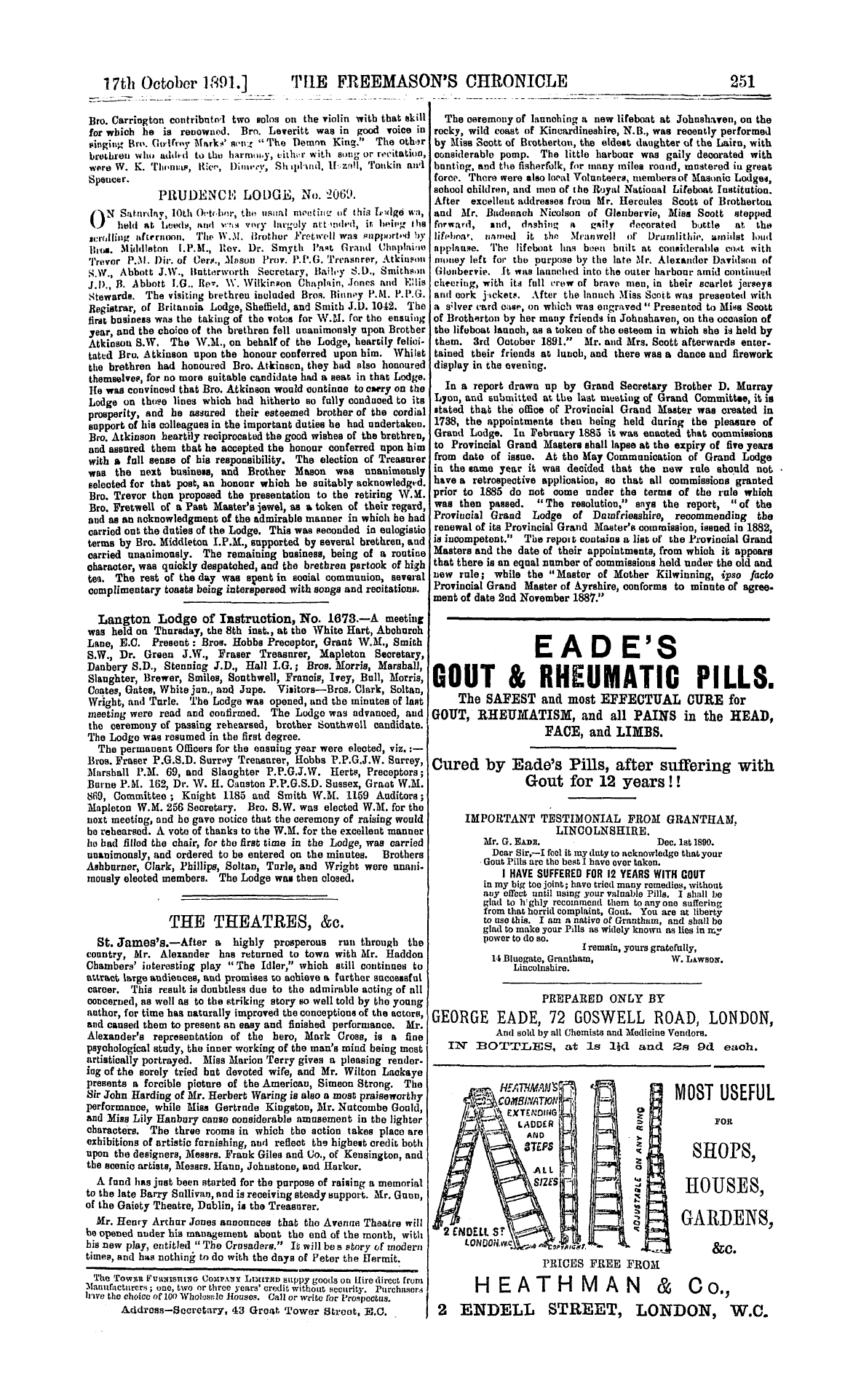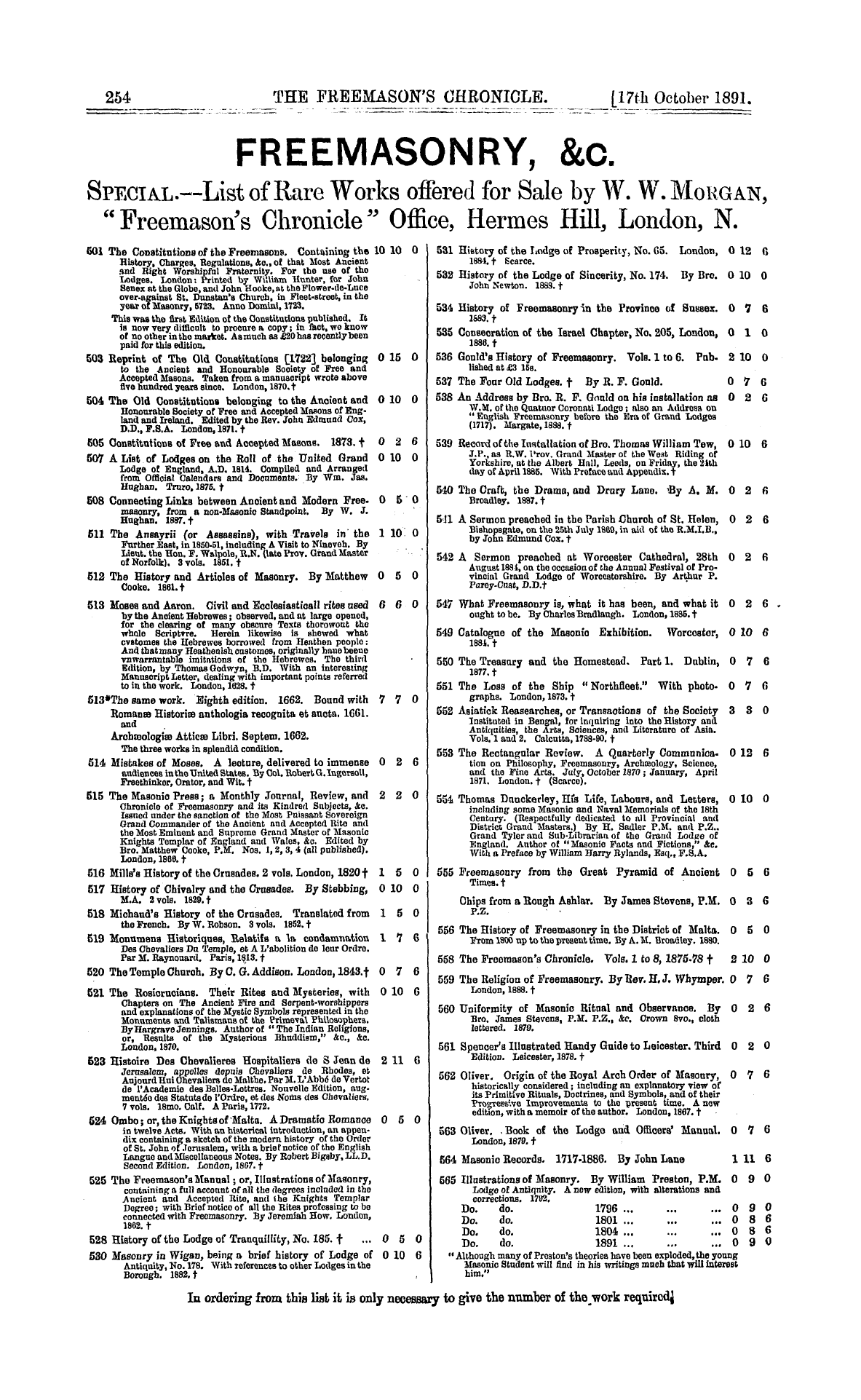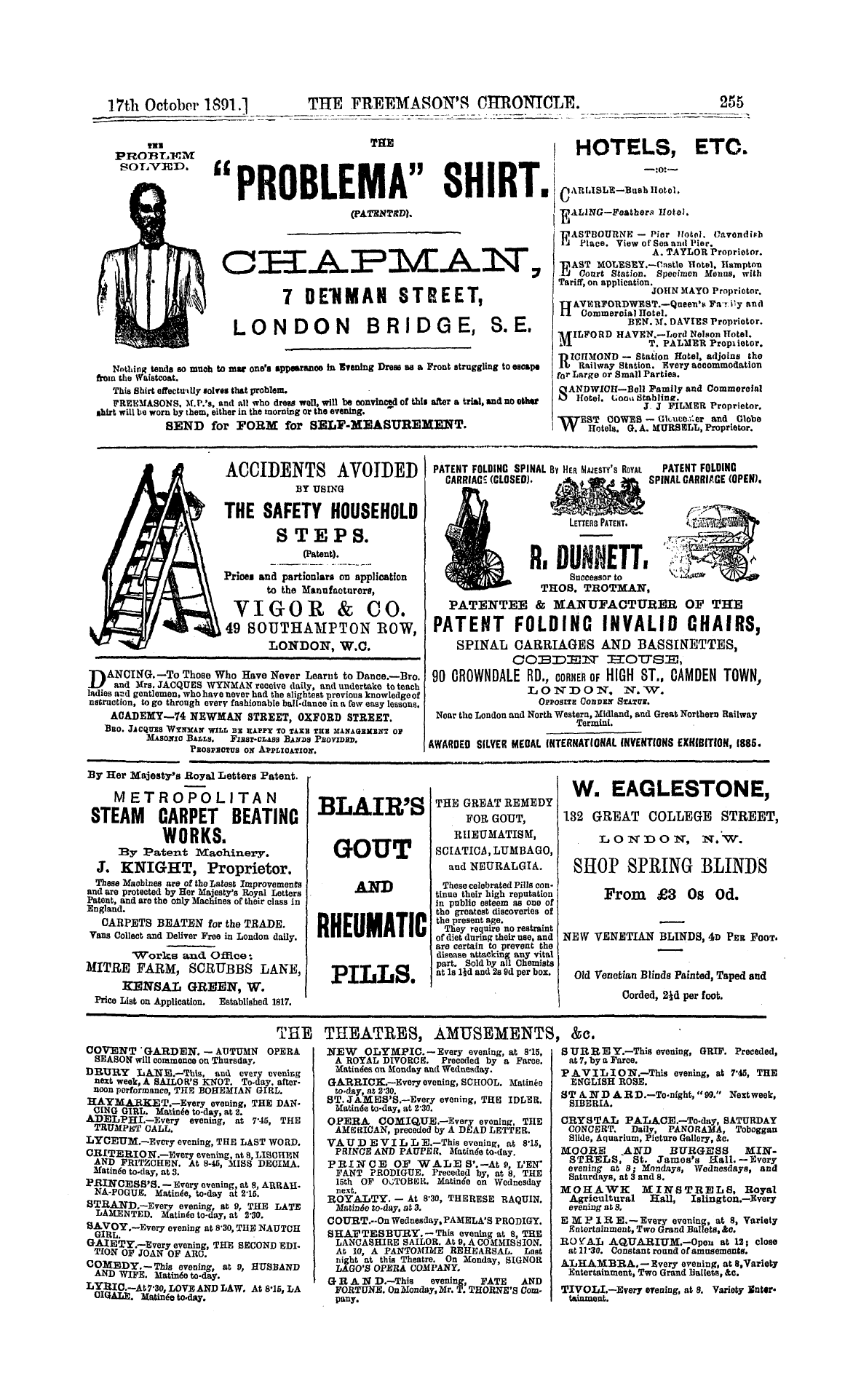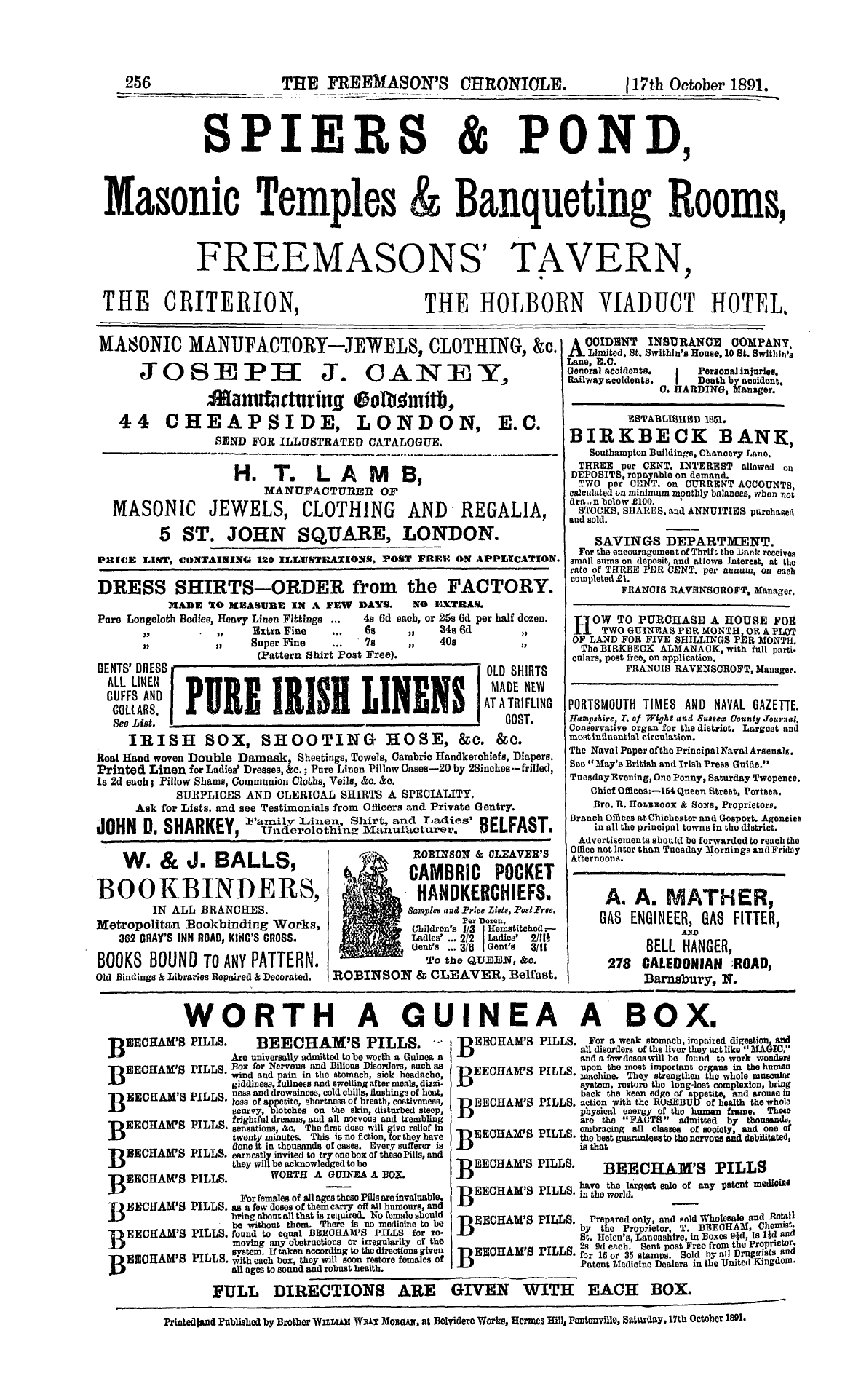-
Articles/Ads
Article A NEW MASONIC HISTORY.* Page 1 of 2 Article A NEW MASONIC HISTORY.* Page 1 of 2 →
Note: This text has been automatically extracted via Optical Character Recognition (OCR) software.
A New Masonic History.*
A NEW MASONIC HISTORY . *
PART III . of this work comprises Divisions XVI . and XVII ., in which " Concordant Orders , and the Chivalric Degrees" are discussed . For reasons already stated , we cannot consider ourselves qualified to criticise this portion of tho ' •History" as we have done and shall do others ; but there are many points which in
the course of perusal we consider will nave interest for the general Masonic reader . These we shall specify as we proceed . Division XVI ., under tho generic title of " Knights Templar and Allied Orders , " consists of three Chapters , together occupying thirty-eight pages , and ia
written by Bro . Frederic Speed 33 ° , a Past R . E . Grand Commander , Mississippi . The first treats of the " Origin of American Templary , and Early Grand Encampments . " Bro . Speed states that the first account of the conferring of the degree of Knight Templar that has been discovered
either in America or Great Britain , is the record of a meeting , 28 th August 1769 , of the St . Andrew ' s Chapter of Royal Arch Masons , of Boston , Massachusetts , then St . Andrew ' s Royal Arch Lodge , holding nnder the Grand Lodge of Scotland . He considers it a mere matter of
conjecture as to whence the ceremony was obtained , or of what it consisted ; and referring to the difficult task of discovering and bringing to light tho true history and ancient work of tho Masonic Fraternity , owing to tho extreme reluctance with which Masons formerly committed to
writing even the most trivial matters relating to the Craft , says : — " Even in this age , when new discoveries are being constantly brought to light , it is far too frequently held
to be treason to the cause to expose to the eyes of the ' profane' the truth of history , so far as it relates to the Masonic Institution ; but , regardless of tho ignorant pretensions of those who still teach that the Master Mason's
degreo originated , and was formerly conferred in the Sanchm Sanctorum of King Solomon ' s Temple , and that the Templars of this year of grace are the lineal descendants of those who fought for the recovery of the Holy Sepulchre , one myth after another has vanished
into thin air , until we no longer hesitate to commit to writing the averment that , with scarcely an exception , the ritual of every Masonic degree now produced in these United States originated , or was elaborated , since the American Revolution and by Americans . The admission
of this fact doos not , however , in the least degree detract from the dignity , high character , or claim to an ancient origin of the Institution itself . " A further remark of the author ' s must , we should think , meet with general agreement : — "It is of course unfortunate that all Masonic
instruction should not be given in chronological progression . The transposition of some of the degrees might have been made , at an early day , with advantage , but it must be apparent to all who observed the great struggle which took place quite recently over tho proposed transfer of the
Cryptic Degrees to the Capitular system , that the order in which the degrees are given has become , notwithstanding the grossest anachronisms , so firmly fixed that no change in the scale of degrees is practicable in this period of Masonic development . " We extract the foregoing from
what may be considered the introductory paragraphs of the Chapter . There are others which are agreeable to our opinions , and are also worth the attention of Craftsmen ; but limit of space prevents quotation . The remainder of the Chapter more particularly interests American Knights
Templars desirous of acquaintance with tne organizations of the several Grand Encampments in the United States . No information is afforded in relation to those at present connected with the United Kingdom . The second Chapter is in continuation of the first , containing an abstract of the
First Constitution of a " General Grand Encampment of Knights Templars , and the Appendant Orders , for the United States of America , " the result of " a convention " hold at Masons' Hall , New York , in June 1816 . This " convention" was attended by four members of the
Order only , who together ware described as delegates from " eig ht councils and encampments . " Their names , and the several encampments they were said to have represented , are given ; and the record of this " immortal quartette ' s proceedings " seems to justify the expressed opinion that
A New Masonic History.*
one of them might , then and there , " have appropriatel y said the old coloured man ' s prayer : ' God bless me and my wife , my son John and his wife , ua four and no more .
Amen ! It does not appear , from what we read , that'this section of Masonry , in America at any rate , has heen throughout of the most harmonions character . Controversies and contentions have been numerous . "
Disciplined obedience to the will of the superior" is a phrase in reference to a Masonic organization which , to our mind , attacks the principle of equality demonstrated by tho level ; and , if it really means the will of an individual autocrat—and not the supreme authority of a
constitutional body of lawgivers , —as the recent , and we believe still continued battle for " prerogative " would lead one to imagine , why the sooner Knight Tomplary ceases to be in any way attached to the " system of morality , " & o . the better for the Craft . It is all very well to be " emulators of the
chivalric virtues , the charitable deeds , the unexampled bravery , Christian heroism , and ennobling self-sacrifice of the ancient Templars , " but in spite of the great number of Americana ( 76 , 886 ) who profess to be such emulators , if harmonions equality is not objeotive amongst
them no benefit to the world at large can accrue from their present organization . We speak as unprejudiced outsiders on this subject , and make bold to do so , believing that many Craftsmen hold the same views as to the nocessity for concord and unanimity if progress and success are to
be secured in any Masonic association , large or small . Wo question very much if Modern Knight Templary is in any way Masonic , except in so far as the requirements of its originators , that its novitiates shall have been previously members of the " pure and simple " Craft degrees , affords
colour to the assumption of direct connection with Freemasonry . Tho third Chapter in this Division is remarkablo for a finely written section on " The Ethics of Templary , " which is equally applicable to Universal Freemasonry . It
will be found at page 734 of the History , and being too lengthy for introduction in this review we shall probably take an early opportunity to reproduce it in the columns of this journal as a separate essay . Bro . Speed's contribution is altogether deserving of commendation .
A melancholy interest is attached to tbe succeeding Division ( XVII . ) as being the last literary labour of the late eminent and greatly esteemed brother Lieut .-Col . W . J . B . MacLeod Moore , Supreme Grand Master " ad vitam " of the Sovereign Great Priory of Canada , United
Orders of the Temple and Malta , & c , & c . A brief " In Memoriam , " accompanied by a well-executed full page likeness and fac-simile autograph of this recognised authority in Masonic lore , fitly precedes the Introduction and seven Chapters , occupying fifty pages , comprised in this
Division . Its subject is " British Templary , " a History of the Modern or Masonic Templar Systems , with a concise account of the origin of Speculative Freemasonry , and its evolution since the Revival , A . D . 1717 . The monograph is dedicated to Bro . T . B . Whytehead , of York ,
" whose matured views on the subject so entirely coincided with my own . " In this preface the author now contends that it is a mistake to connect Templary with Freemasonry , although at one time he believed a union had existed betwen the ancient builders , " Stone-masons , " and the chivalric orders . After most careful and exhaustive
research he discovers this to be a mere delusion , devoid of all truth . He refers to former criticisms made b y him in the course of a nearly Bixty years' Masonic lifetime , of which about half a century was in connection with Templary , and " to the glaring discrepancies and
inconsistencies existing , which prove the system to ho not only false , but a perversion of the principles of the true Templar Order from which it derives its name—merely an imitation military Masonic degree , —a parody upon tho pure doctrines of the ancient Templars . " He remarks that " the
Freemasonry of the 'revival' inculcates the doctrine of Theism ; that of Templary is , and has always been , Trinitarian Christian . " And again , "true modern Templary is a Christian society of the most orthodox kind , in no way forming a part of the universal system of Speculative
Freemasonry , " and he pertinently asks how can two such contradictory and antagonistic elements be transformed into degrees of the universal system of Freemasonry without destroying the vital characteristics of both ? " There is no
such thing as Masonic knighthood ! Any such claim or usage is but a childish fable . The honours of knighthood can only be conferred by the Sovereign of the realm , or the representative of the Sovereign , duly authorised . "
Note: This text has been automatically extracted via Optical Character Recognition (OCR) software.
A New Masonic History.*
A NEW MASONIC HISTORY . *
PART III . of this work comprises Divisions XVI . and XVII ., in which " Concordant Orders , and the Chivalric Degrees" are discussed . For reasons already stated , we cannot consider ourselves qualified to criticise this portion of tho ' •History" as we have done and shall do others ; but there are many points which in
the course of perusal we consider will nave interest for the general Masonic reader . These we shall specify as we proceed . Division XVI ., under tho generic title of " Knights Templar and Allied Orders , " consists of three Chapters , together occupying thirty-eight pages , and ia
written by Bro . Frederic Speed 33 ° , a Past R . E . Grand Commander , Mississippi . The first treats of the " Origin of American Templary , and Early Grand Encampments . " Bro . Speed states that the first account of the conferring of the degree of Knight Templar that has been discovered
either in America or Great Britain , is the record of a meeting , 28 th August 1769 , of the St . Andrew ' s Chapter of Royal Arch Masons , of Boston , Massachusetts , then St . Andrew ' s Royal Arch Lodge , holding nnder the Grand Lodge of Scotland . He considers it a mere matter of
conjecture as to whence the ceremony was obtained , or of what it consisted ; and referring to the difficult task of discovering and bringing to light tho true history and ancient work of tho Masonic Fraternity , owing to tho extreme reluctance with which Masons formerly committed to
writing even the most trivial matters relating to the Craft , says : — " Even in this age , when new discoveries are being constantly brought to light , it is far too frequently held
to be treason to the cause to expose to the eyes of the ' profane' the truth of history , so far as it relates to the Masonic Institution ; but , regardless of tho ignorant pretensions of those who still teach that the Master Mason's
degreo originated , and was formerly conferred in the Sanchm Sanctorum of King Solomon ' s Temple , and that the Templars of this year of grace are the lineal descendants of those who fought for the recovery of the Holy Sepulchre , one myth after another has vanished
into thin air , until we no longer hesitate to commit to writing the averment that , with scarcely an exception , the ritual of every Masonic degree now produced in these United States originated , or was elaborated , since the American Revolution and by Americans . The admission
of this fact doos not , however , in the least degree detract from the dignity , high character , or claim to an ancient origin of the Institution itself . " A further remark of the author ' s must , we should think , meet with general agreement : — "It is of course unfortunate that all Masonic
instruction should not be given in chronological progression . The transposition of some of the degrees might have been made , at an early day , with advantage , but it must be apparent to all who observed the great struggle which took place quite recently over tho proposed transfer of the
Cryptic Degrees to the Capitular system , that the order in which the degrees are given has become , notwithstanding the grossest anachronisms , so firmly fixed that no change in the scale of degrees is practicable in this period of Masonic development . " We extract the foregoing from
what may be considered the introductory paragraphs of the Chapter . There are others which are agreeable to our opinions , and are also worth the attention of Craftsmen ; but limit of space prevents quotation . The remainder of the Chapter more particularly interests American Knights
Templars desirous of acquaintance with tne organizations of the several Grand Encampments in the United States . No information is afforded in relation to those at present connected with the United Kingdom . The second Chapter is in continuation of the first , containing an abstract of the
First Constitution of a " General Grand Encampment of Knights Templars , and the Appendant Orders , for the United States of America , " the result of " a convention " hold at Masons' Hall , New York , in June 1816 . This " convention" was attended by four members of the
Order only , who together ware described as delegates from " eig ht councils and encampments . " Their names , and the several encampments they were said to have represented , are given ; and the record of this " immortal quartette ' s proceedings " seems to justify the expressed opinion that
A New Masonic History.*
one of them might , then and there , " have appropriatel y said the old coloured man ' s prayer : ' God bless me and my wife , my son John and his wife , ua four and no more .
Amen ! It does not appear , from what we read , that'this section of Masonry , in America at any rate , has heen throughout of the most harmonions character . Controversies and contentions have been numerous . "
Disciplined obedience to the will of the superior" is a phrase in reference to a Masonic organization which , to our mind , attacks the principle of equality demonstrated by tho level ; and , if it really means the will of an individual autocrat—and not the supreme authority of a
constitutional body of lawgivers , —as the recent , and we believe still continued battle for " prerogative " would lead one to imagine , why the sooner Knight Tomplary ceases to be in any way attached to the " system of morality , " & o . the better for the Craft . It is all very well to be " emulators of the
chivalric virtues , the charitable deeds , the unexampled bravery , Christian heroism , and ennobling self-sacrifice of the ancient Templars , " but in spite of the great number of Americana ( 76 , 886 ) who profess to be such emulators , if harmonions equality is not objeotive amongst
them no benefit to the world at large can accrue from their present organization . We speak as unprejudiced outsiders on this subject , and make bold to do so , believing that many Craftsmen hold the same views as to the nocessity for concord and unanimity if progress and success are to
be secured in any Masonic association , large or small . Wo question very much if Modern Knight Templary is in any way Masonic , except in so far as the requirements of its originators , that its novitiates shall have been previously members of the " pure and simple " Craft degrees , affords
colour to the assumption of direct connection with Freemasonry . Tho third Chapter in this Division is remarkablo for a finely written section on " The Ethics of Templary , " which is equally applicable to Universal Freemasonry . It
will be found at page 734 of the History , and being too lengthy for introduction in this review we shall probably take an early opportunity to reproduce it in the columns of this journal as a separate essay . Bro . Speed's contribution is altogether deserving of commendation .
A melancholy interest is attached to tbe succeeding Division ( XVII . ) as being the last literary labour of the late eminent and greatly esteemed brother Lieut .-Col . W . J . B . MacLeod Moore , Supreme Grand Master " ad vitam " of the Sovereign Great Priory of Canada , United
Orders of the Temple and Malta , & c , & c . A brief " In Memoriam , " accompanied by a well-executed full page likeness and fac-simile autograph of this recognised authority in Masonic lore , fitly precedes the Introduction and seven Chapters , occupying fifty pages , comprised in this
Division . Its subject is " British Templary , " a History of the Modern or Masonic Templar Systems , with a concise account of the origin of Speculative Freemasonry , and its evolution since the Revival , A . D . 1717 . The monograph is dedicated to Bro . T . B . Whytehead , of York ,
" whose matured views on the subject so entirely coincided with my own . " In this preface the author now contends that it is a mistake to connect Templary with Freemasonry , although at one time he believed a union had existed betwen the ancient builders , " Stone-masons , " and the chivalric orders . After most careful and exhaustive
research he discovers this to be a mere delusion , devoid of all truth . He refers to former criticisms made b y him in the course of a nearly Bixty years' Masonic lifetime , of which about half a century was in connection with Templary , and " to the glaring discrepancies and
inconsistencies existing , which prove the system to ho not only false , but a perversion of the principles of the true Templar Order from which it derives its name—merely an imitation military Masonic degree , —a parody upon tho pure doctrines of the ancient Templars . " He remarks that " the
Freemasonry of the 'revival' inculcates the doctrine of Theism ; that of Templary is , and has always been , Trinitarian Christian . " And again , "true modern Templary is a Christian society of the most orthodox kind , in no way forming a part of the universal system of Speculative
Freemasonry , " and he pertinently asks how can two such contradictory and antagonistic elements be transformed into degrees of the universal system of Freemasonry without destroying the vital characteristics of both ? " There is no
such thing as Masonic knighthood ! Any such claim or usage is but a childish fable . The honours of knighthood can only be conferred by the Sovereign of the realm , or the representative of the Sovereign , duly authorised . "















